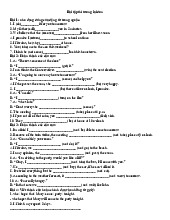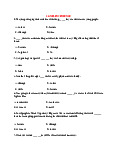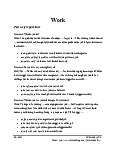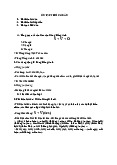


Preview text:
Venus in Transit Questions 14-17
Reading Passage 2 has seven
June 2004 saw the first passage (sự đi ngang qua), known as a paragraphs, A-G.
'transit’ of the planet Venus across the face of the Sun in 122 years.
Which paragraph contains the following
Transits have helped shape our view of the whole Universe, as information?
Heather Cooper and Nigel Henbest explain.
Write the correct letter A-G, in boxes 14-
Since …, no one can be naïve about the way media shape our 17 on your answer sheet.
view of the world. 14. examples of different in which ways A
the parallax principle has been applied
On 8 June 2004, more than half the population of the world were 15. a description of which an event
treated to a rare astronomical event. For over six hours, the planet
prevented a transit observation
Venus steadily inched (nhích từng chút) its way over the surface of
16. a statement about potential future
the Sun. This “transit` of Venus was the first since 6 December l882. discoveries leading on from transit
On that occasion, the American astronomer Professor Simon observations G
Newcomb led a party to South Africa to observe the event. They
17. a description of physical states
were based at a girls' school, where - it is alleged (cho là, dẫn
connected with Venus which early
chứng) – the combined forces of three schoolmistresses
astronomical instruments failed to
outperformed (vượt qua) the professionals with the accuracy of their overcome E observations.
The astronomical events of Venus in transit Questions 18-21
have attracted explorers all over the world. NG
Look at the following statements B
(Questions 18-21) and the list of people
For centuries, transits of Venus have drawn explorers and below
astronomers alike to the four corners of the globe. And you can put
Match each statement with the correct
it all down to (= be attributed to: được cho là do) the extraordinary person, A, B, C or D.
‘polymath (nhà bác học) Edmond Halley. In November 1677,
Write the correct letter A, B, C or D. in
Halley observed a transit of the innermost (phía trong cùng, tận đáy boxes 18-21 on your answer sheet.
lòng) planet Mercury, from the desolate (hoang vắng)island of St
Helena in the South Pacific. He realized that from different latitudes 18. He calculated the distance of the Sun
(vĩ độ), the passage of the planet across the Sun's disc would appear from the based on Earth observations of
to differ. By timing the transit from two widely-separated locations, Venus with a fair degree of accuracy. D
teams of astronomers could calculate the parallax angle (góc thị sai)
19. He understood that the of distance
- the apparent difference in position of an astronomical body the Sun from the could be worked Earth
due to a difference in the observer's position. Calculating this
out by comparing observations of a
angle would allow astronomers to measure what was then the transit. A
ultimate goal; the distance of the Earth from the Sun. This
20. He realized that the time taken by a
distance is known as the 'astronomical unit` or AU.
planet to go round the Sun depends on
FALL/SLOT into place: hiểu đc 1 vđề
its distance from the Sun. B
kkhăn,ptạp; 1 vđề ptạp bđầu rràng3 21. He a witnessed Venus but transit C
was unable to make any calculations.C
Halley was aware that the AU was one of the most fundamental of
all astronomical measurements. Johannes Kepler, in the early 17th List of People
century, had shown that the distances of the planets from the Sun A. Edmond Halley
governed (chi phối) their orbital speeds, which were easily B. Johannes Kepler
measurable. But no-one had found a way to calculate accurate C. Guillaume Le Gentil
distances to the planets from the Earth. The goal was to measure the D. Johann Franz Encke
AU; then, knowing the orbital speeds of all the other planets round
the Sun, the scale of the Solar System would fall into place. Questions 22-26
However, Halley realized that Mercury was so far away that its
Do the following statements agree with
parallax angle would be very difficult to determine. As Venus was
the information given in Reading Passage
closer to the Earth, its parallax angle would be larger and Halley 2?
worked out that by using Venus it would be possible to measure the Write answers in boxes 22-26 on your
Sun`s distance to 1 part in 500. But there was as problem: transits of answer sheet. write
Venus, unlike those of Mercury; are rare, occurring in pairs roughly
eight years apart every hundred or so years. Nevertheless, he
TRUE it the statement agrees with the
accurately predicted that Venus would cross the face of the Sun in information
both 1761 and 1769 - though he didn`t survive to see either.
FALSE if the statement contradicts the information D
NOT GIVEN if there is no information
Inspired by Halley's suggestion of a way to pin down (ghim chặt, on this
xđịnh rõ) the scale of the Solar System, teams of British and French
astronomers set out on expeditions to places as diverse as India and 22. Halley
observed one transit of the
Siberia. But things weren’t helped by Britain and France being at planet Venus. FALSE
war. The person who deserves most sympathy is the French 23. managed to Le Gentil observe a
astronomer Guillaume Le Gentil. He was thwarted (cản trở) by the
second Venus transit. FALSE
fact that the British were besieging (bao vây, vây hãm) his
24. The shape of Venus appears distorted
observation site at Pondicherry in India. Fleeing on a French
when it starts to pass in front of the Sun.
warship crossing the Indian Ocean, Le Gentil saw a wonderful TRUE
transit - but the ship`s pitching and rolling (lắc lư, tròng tràn) ruled
25. Early astronomers suspected that the
out (= exclude, prevent: ngăn cản, làm mất đi cơ hội) any attempt at
atmosphere on Venus was toxic. NOT
making accurate observations. Undaunted (k nản lòng), he remained GIVEN
south of the equator, keeping himself busy by studying the islands
26. The parallax principle allows
of Mauritius and Madagascar before setting off (khởi hành, lên
astronomers to work out how far away
đường) to observe the next transit in the Philippines. Ironically, after distant stars are from the Earth. TRUE
travelling nearly 50,000 kilometres, his view was clouded out at the
last moment, a very dispiriting (làm nản lòng) experience. E
While the early transit timings were as precise as instruments
would allow the measurements were dogged (gây trở ngại) by the
'black drop' effect. When Venus begins to cross the Sun's disc, it
looks smeared (nhem nhuốc) not circular - which makes it difficult
to establish timings. This is due to diffraction (Sự nhiễu xạ) of light.
The second problem is that Venus exhibits (phô bày) a halo (vầng
hào quang, ánh sáng) of light when it is seen just outside the Sun's
disc. While this showed astronomers that Venus was surrounded by
a thick layer of gases refracting (khúc xạ) sunlight around it, both
effects made it impossible to obtain accurate timings. F
But astronomers labored hard to analyze the results of these
expeditions to observe Venus transits. Jonathan Franz Encke,
Director of the Belin Observatory, finally determined a value for the
AU based on all these parallax measurements: 153340,000 km.
Reasonably accurate for the time, that is quite close to today's value
of 149,597,870 km, determined by radar, which has now superseded
(thay thế) transits and all other methods in accuracy. The AU is a
cosmic measuring rod, and the basis of how we scale the Universe
today The parallax principle can be extended to measure the
distances to the stars. If we look at a star in January - when Earth is
at one point in its orbit - it will seem to be in a different position
from where it appears six months later. Knowing the width of
Earth`s orbit, the parallax shift lets astronomers calculate the distance.
G June 2004’s transit of Venus was thus more of an astronomical
spectacle than a scientifically important event. But such transits
have paved the way for what might prove to be one of the most vital
breakthroughs in the cosmos - detecting Earth-sized planets orbiting other stars.




